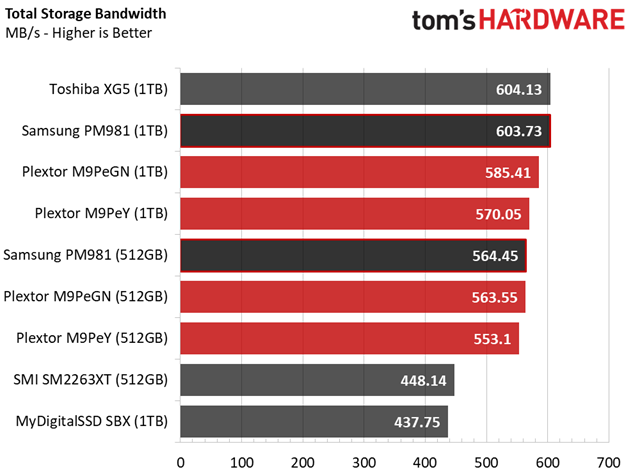Plextor M9Pe SSD Review
Why you can trust Tom's Hardware
Conclusion
The Plextor M9Pe series comes to market as we’re crawling out of the worst NAND shortage in history. The flash shortage spurred the SSD price increases. As supply returns, it’s the same component that will bring us the first SSD oversupply in nearly six years.
We expect to see the same explosive growth in 2018, but there are differences. Intel’s Optane SSD holds an uncontested position at the top of the performance segment. Professional users that can’t settle for TLC have an option, but that removes a sliver of the SSD market.
The SSD market doesn't shrink because a portion of the market is cut off, though—lower pricing will push flash the other direction. The notebook market has already embraced flash, but adoption is still lower than expected. If we didn’t have the NAND shortage, SSDs would already ship in low-cost notebooks at brick and mortar retailers. The OEM and business-class desktops are the next frontier. Those markets ship in higher volume than professional workstations.
In our review of the Samsung PM981 OEM NVMe SSD, we could see the future of high-end NAND-based SSDs in 2018. The new Plextor M9Pe is competitive in that future. This chart includes every 64-layer TLC NVMe drive we have. The SSDs cede the top performance tier to Optane and most offer similar performance. This is like the 2012 consumer SATA SSD market all over again, just with a different protocol on the front end.
The Plextor M9Pe will become better as we get deeper into 2018. Not only will the existing MLC products fall off the map, but Plextor will also improve the drive. Plextor has a good track record of firmware improvements; the company updated the M8Pe firmware five times already. The M8Se is less than six months old and already has two new revisions. Each revision improves performance. Some products didn't review well in the past but became very good products later (like the M6 Pro after six firmware revisions).
We like Plextor's three-prong strategy with the M series because we can purchase exactly what we need. Even though we didn't test it, the M.2 M9PeG with a heatsink is our favorite option. It doesn't populate a PCIe slot and should provide enough cooling capacity for normal workloads. The Marvell Eldora controller runs warm, but all you need is a small cooler to delay throttling for several minutes. With these transfer speeds, a few minutes is all you need to transfer a lot of data.
The M9 Series falls short on the software side. Plextor's SATA products have an amazing software suite, but it doesn't carry over to the NVMe products. Value-add pieces like Plextor's software help sell drives in a congested market. Unfortunately, the M-Series products are locked out and can't take advantage of the software.
Get Tom's Hardware's best news and in-depth reviews, straight to your inbox.
We still prefer the M8Pe with MLC flash, but the M9Pe provides a good user experience for less money. Plextor will work on the firmware as the company navigates the new 64-layer flash. Hopefully, they can correct some of the latency and background activity issues with a future update.
MORE: Best SSDs
MORE: How We Test HDDs And SSDs
MORE: All SSD Content

Chris Ramseyer was a senior contributing editor for Tom's Hardware. He tested and reviewed consumer storage.
-
WyomingKnott "We'll see more new products introduced than ever before with higher capacities, newer controllers, and lower price points."Reply
And, sadly, falling performance as drives are no longer made with single-bit cell flash. I'm positive that cheaper will drive out faster in this area; I'm curious as to whether a high-end segment will persist or if we have actually reached peak performance for flash SSDs and it will be all downhill from here. Will last year's best SSDs be traded like rare antiques someday? -
richardvday Sadly the editing in these articles is horrible anymore. This article is rife with bad punctuation and missing words so the sentences make no sense without them.Reply
Many articles come out like this anymore here its really getting bad. -
Sakkura Reply20549352 said:"We'll see more new products introduced than ever before with higher capacities, newer controllers, and lower price points."
And, sadly, falling performance as drives are no longer made with single-bit cell flash. I'm positive that cheaper will drive out faster in this area; I'm curious as to whether a high-end segment will persist or if we have actually reached peak performance for flash SSDs and it will be all downhill from here. Will last year's best SSDs be traded like rare antiques someday?
3DXPoint will cover the extreme performance segment just fine. What people want from flash SSDs is more GB per dollar. And it looks like 2018 will finally start to get us back on track there.
20549381 said:Wondering where 960 evo stands in those graphs...
It's included in the 1TB graphs. Probably would turn up in about the same place in the ½TB graphs. -
cerealkeller The box is deceiving, it makes you think the PCI-E version has an integrated fan. Which it probably should if thermal throttling is an issue.Reply

